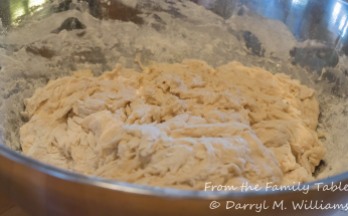San Francisco is one of those lucky cities that has lots of really great bakeries turning out really great bread. If you are a bread lover, as I am, that’s important. Of course, it is arguable as to which is the best bakery or best loaf, but Tartine Bakery and their basic country bread have to be on just about everyone’s lists.
Chad Robertson, the co-owner of Tartine Bakery, has roots in West Texas, but he has travelled to France and probably other places to perfect his craft. He still bakes 250 loaves of bread a day when he is in town. He is driven in his quest to make the best loaf of bread he can, along with pastries and other baked goods. But he is generous in sharing his knowledge. Other chefs in San Francisco have been mentored by him, and now their bread is well-known. An example of that is Outerlands in the Outer Sunset district of San Francisco. Their grilled cheese sandwich on thick slices of house-baked bread is justifiably famous.
Robertson is now getting ready to install a custom-made behemoth of an oven in a new space in San Francisco so that he can increase his baking production. He is planning to open bakeries in Tokyo and maybe London and New York.
He has also written or taken photographs for several cookbooks, including a beautiful book, Tartine Bread (Chronicle Books, San Francisco, 2010). That classic (already) gives detailed instructions and beautiful photos for the home baker. The book also describes Robertson’s method to replicate the characteristics of a baker’s oven in the home. The problem is that the chapter on the basic loaf is 38 pages long, and the recipe itself is 26 pages long. That might be enough to put you off from trying your hand. That would be too bad, because by using those instructions, even a novice (me) can produce the best loaf of homemade bread that he or she has ever made.
You will need to be ready with your own sourdough starter that you have developed, stored, and if necessary rejuvenated by daily feedings of flour and water. I have previously posted several methods to begin your own sourdough starter. You should also have the equipment for the process. These items can be purchased from King Arthur Flour, Breadtopia, and of course, Amazon if you can’t find them locally.
The recipe is based upon weight rather than volume (the standard for professional bakers), so you will need a reliable kitchen scale capable of registering metric weights.
One essential piece of equipment is the Lodge cast-iron combo-cooker. It has shallow and deep halves. The shallow half serves as the baking surface while the deep half covers the loaf and provides the necessary heat above the loaf for the steam needed for good lift and crisp crust. You can use a regular Dutch oven with the deep half on the bottom, but that makes it awkward to handle the loaf at 500°F and with oven mitts. Undoubtedly I would burn myself seriously with such an arrangement.
For the fermentation process, you can use any large, clear plastic or glass container, but the container from King Arthur Flour or Breadtopia is especially convenient.
Two bowls lined with clean dish towels will work to hold the loaves during their final rise before baking, but woven bannetons with their special liners are very handy. They are available from Breadtopia.
To make it easier for me to follow Robertson’s instructions without ruining my pristine copy of his book with flour-covered hands, I have condensed the instructions to numbered steps on a sheet of paper that can be stuck on the refrigerator door. Here are those instructions.

Dough mixed by hand in a large metal bowl

Clear plastic container perfect for fermentation

Dough starts the rising/fermentation process in the clear plastic container

Dough cut in half and shaped into two loaves

Two woven bannetons and white cloth liners

Lodge combo-cooker. The bread is baked in the shallow half, and the heat and steam are provided by the deep half.

Finished loaf straight from the oven

The bread needs to cool before slicing (Hard to wait)

Sliced and ready to eat
RECIPE
Tartine Bakery Basic Bread
Equipment
- kitchen balance reading in grams
- large metal mixing bowl
- rubber spatula
- 8 quart plastic or glass fermenting container
- bench knife
- 2 bannetons with cloth liners
- kitchen towels
- Lodge cast iron combo cooker
- oven mitts
- lame (you can use a new single-edged razor blade or sharp knife)
Ingredients
Leaven
- sourdough starter
- 200 grams warm (78°F) water
- 200 grams 50/50 flour blend (white bread flour/whole wheat flour)
Bread
- 700+50 grams water (80°F)
- 200 grams leaven
- 900 grams white bread flour
- 100 grams whole wheat flour
- 20 grams salt
- 50/50 rice/wheat flour mixture
- rice flour
Method
The night before: Developing the leaven
- Discard all but I tablespoon of starter.
- Add 200 grams of warm water.
- Add 200 grams of 50/50 flour blend.
- Stir until well mixed.
- Cover loosely with a towel and let stand in a warm place over night.
Baking Day
- Test the leaven by dropping a spoonful in a cup of water. If it floats, it is ready to be used. Otherwise let it work until it floats.
- Pour 700 grams of water into a large metal mixing bowl.
- Add 200 grams of the leaven and stir to mix.
- Add the bread flour and whole wheat flour. Mix thoroughly by hand until there is no loose flour.
- Allow the dough to rest for 30 to 40 minutes.
- Add salt and the remaining 50 grams of water to the rested dough. Squeeze the dough between your fingers to incorporate the salt and water.
- Fold the dough onto itself and transfer to the fermenting container. The dough will not rise much at this stage.
- Allow the dough to rise for 3 to 4 hours at 78 – 82°F, giving the dough one turn every half hour for the first 2 hours. Turn by dipping one hand in water, grab the underside of the dough with the wet hand, stretch it up, and fold it back over the remaining dough, repeating three times. After the second hour, turn the dough more gently so as not to deflate.
- Continue to let rise, with the turning process, until the dough releases from the sides of the container, ridges left by the turn hold their shape for a few minutes, and the dough increases by one-quarter to one-third in volume.
- Pull the dough out of the container onto an un-floured work surface with the spatula. Lightly flour the surface of the dough, and then cut it into two equal pieces with the bench knife. Flip the two pieces of dough so that the floured surfaces are on the work surface, and seal the raw dough with the floured surface.
- Work the dough into loaf shapes using your hands and the bench knife. Then let them rest for 20 to 30 minutes. Lightly flour and cover with a towel to prevent drafts.
- Form the final loaves by lightly flouring the top surface and then flipping the dough rounds so that the floured surface rests on the work surface.
- Working with one round at a time, fold a third of the dough closest to you over the middle third. Stretch the dough to the right and fold this over the center. Then stretch to the left and fold over the previous fold, anchoring with your fingers. Then grab the dough closest to you, and wrap it over the loaf while rolling so that the smooth underside is now the top, and the seams are on the bottom.
- Put the ball of dough between your hands and pull it toward you, rounding it at the same time to stretch the surface and close the seam. Let the shaped loaf rest for a few minutes while you repeat with the second loaf.
- Dust the lined bannetons with the rice/wheat flour mixture. Transfer the shaped loaves to the baskets with the bench knife so that the smooth sides are down.
- Let rise, covered with a towel, at 75-80°F for 3 to 4 hours.
- About 20 minutes before you are ready to bake, place the combo cooker with its lid in the middle of an oven preheated to 500°F.
- Dust one of the loaves with rice flour. Then remove the shallow lid of the combo cooker from the oven, and place it on the stove, using oven mitts, and leaving the deep half in the oven. Turn the dough into the hot pan. Score the top of the loaf with the sharp lame or razor blade. Then return the filled shallow pan to the oven, and cover with the deep half. Immediately reduce the temperature to 450°F.
- Bake for 20 minutes. Then using the oven mitts, remove the top and continue to bake for 20 to 25 minutes
- Again wearing oven mitts, remove the pan from the oven and transfer the loaf to a cooling rack to cool completely
- For the second loaf, wipe out the cooker, reheat for 10 minutes in a 500°F and repeat the process used for the first loaf.
- Cool completely before slicing.
































































